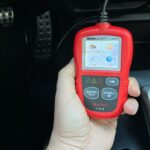The OBD2 code P0455, often encountered in Nissan vehicles, signals a “Gross Leak Detected in Evaporative Emission Control System.” This essentially means your Nissan’s onboard computer has detected a significant leak within the EVAP system. This system is crucial for preventing harmful fuel vapors from escaping into the atmosphere, contributing to both environmental protection and your vehicle’s fuel efficiency.
Diagnosing a P0455 code in your Nissan can seem daunting, but understanding the common causes and adopting a systematic approach can simplify the process. Often, the most straightforward and frequently overlooked culprit is something as simple as your gas cap.
Common Causes of Nissan P0455 Code
While the P0455 code indicates a large EVAP leak, pinpointing the exact source requires careful inspection. Here are the typical components to investigate on your Nissan:
-
Loose or Damaged Gas Cap: This is the most frequent offender. A gas cap that isn’t properly tightened, or has deteriorated seals, can fail to create an airtight seal, leading to a gross leak. Gas caps have two seals: an easily visible outer O-ring and an internal, spring-loaded valve. Both must be in good working order to prevent leaks.
-
EVAP System Hoses and Lines: The EVAP system uses a network of hoses and lines to route fuel vapors. Cracks, disconnections, or damage to these components can create leaks. Age and environmental factors can cause these rubber and plastic parts to degrade over time.
-
Canister Vent Valve: This valve is designed to open during refueling to release air from the fuel tank and close during normal operation and EVAP system tests. A malfunctioning vent valve that remains stuck open can cause a P0455 code.
-
Purge Valve: The purge valve controls the flow of fuel vapors from the EVAP system into the engine to be burned. If this valve is stuck open or leaking, it can also trigger a P0455 code.
-
Fuel Tank Pressure Sensor: Although less common for a gross leak, a faulty fuel tank pressure sensor can sometimes provide incorrect readings, leading the computer to mistakenly register a P0455 code.
Diagnosing and Resolving Nissan P0455
When faced with a P0455 code on your Nissan, start with the easiest and most probable cause: the gas cap.
-
Gas Cap Inspection:
- Visual Check: Remove the gas cap and inspect it. Look for cracks, damage, or a worn or missing rubber O-ring seal.
- Tighten Securely: Ensure the gas cap is properly tightened until it clicks several times.
- Replacement: If the gas cap appears damaged or old, replacing it is an inexpensive first step.
-
Visual Inspection of EVAP System Components:
- Hoses and Lines: Carefully examine all accessible EVAP hoses and lines in the engine bay and underneath the vehicle. Look for cracks, breaks, disconnections, or signs of damage.
- Valves and Canister: Inspect the canister vent valve and purge valve for any visible damage or loose connections.
-
Professional Smoke Test: If a visual inspection doesn’t reveal the leak, a smoke test is the next logical step. Automotive technicians use professional smoke machines to introduce a safe, visible smoke into the EVAP system. The escaping smoke will pinpoint the location of the leak. While DIY smoke machines exist, caution is advised, especially near the fuel system. Professional equipment ensures safety and controlled smoke generation.
-
Component Testing: If the smoke test is inconclusive or you suspect a specific component, further testing might be necessary. This could involve using a scan tool to monitor sensor readings or testing valve functionality.
Prevention and Maintenance
Regular maintenance can help prevent EVAP system leaks and P0455 codes in your Nissan:
- Gas Cap Condition: Periodically inspect your gas cap for wear and tear, replacing it as needed, especially if you notice any cracks or seal damage.
- Routine Inspections: During regular vehicle maintenance, ask your mechanic to visually inspect the EVAP system hoses and components for any signs of damage or deterioration.
Conclusion
The Nissan OBD2 code P0455 indicates a significant evaporative emission system leak, but it’s often resolvable with a systematic approach. Starting with the gas cap and progressing through visual inspections and potentially a smoke test can effectively diagnose and fix the issue. Addressing a P0455 code promptly ensures your Nissan runs efficiently, reduces emissions, and avoids potential further complications. Remember, when dealing with fuel systems, safety should always be a priority. If you are uncomfortable performing these diagnostics yourself, seeking professional assistance from a qualified mechanic is always recommended.
